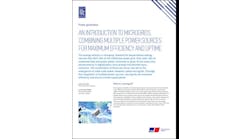The U.S. Department of Energy (DOE) is now accepting applications for its Community Microgrid Assistance Partnership (C-MAP) initiative, which aims to help remote, rural and electrically isolated communities leverage microgrid technologies to improve energy reliability and security.
Administered by the National Renewable Energy Laboratory (NREL) for the DOE’s Office of Electricity, the program targets local governments, power companies, independent energy suppliers and community support organizations that provide energy services to underserved and/or indigenous populations in Alaska and Hawaii, as well as tribal communities in the Southwest and Great Plains.
“Remote communities are well-positioned to demonstrate optimized microgrid technologies, including those that generate renewable energy locally,” said Geri Richmond, DOE Under Secretary for Science and Innovation. “With the right design and innovation, microgrid solutions will help lower energy costs, improve energy resilience, and spur economic opportunities.”
Technical assistance and funding available
The program will provide technical assistance and/or funding to eligible communities or groups of communities for the design and implementation of microgrid systems.
C-MAP is also accepting proposals from eligible applicants seeking to optimize existing microgrids.
Applications are being accepted through December 20 and selections will be announced in early 2025.
Tribal, remote communities increasingly adopting microgrids
Microgrids are growing more prominent in tribal, remote and underserved communities.
Pacific Gas and Electric (PG&E) is actively expanding its remote microgrid program, which was first launched in 2021 in Briceburg, California. The utility has five remote microgrids in operation, including its first without fossil fuels at Pepperwood Preserve in Sonoma County. Seven new installations are slated to come online in 2024.
The DOE has been active in funding microgrids for underserved communities of late. The agency’s Loan Programs Office recently announced its first tribal loan guarantee for a microgrid for the Viejas Band of Mission Indians near Alpine, California.
In Alaska, the DOE’s Office of Clean Energy Demonstrations provided a $26 million grant study the impact of adding solar and storage to diesel-powered microgrids in the communities of Anvik, Grayling, Holy Cross, Huslia, Kaltag, Minto, Nulato and Shageluk.
Partnership network to multiply the impact
The C-MAP initiative will leverage a large partnership network to help selectees create workforce development programs, raise capital, network their microgrid with other microgrid systems, plan for long-term maintenance and more.
The partnership network includes the NREL and other national labs, the DOE’s Offices of Arctic Energy and Indian Energy, universities and non-profit organizations.
“I am proud that these projects will provide much-needed assistance and support for the participating remote communities and tribes, but I’m also excited to see what they will teach us about using microgrids as building blocks for reliability, resilience, and affordability in an increasingly complex energy system,” said Gene Rodrigues, Assistant Secretary for the DOE Office of Electricity.
Additional information on the C-MAP program, including eligibility requirements, can be found here. More details and submission instructions are available here.








